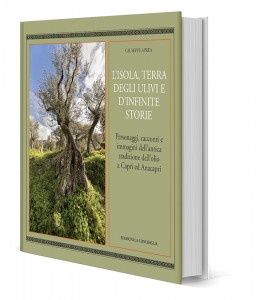L’isola, terra degli ulivi e d’infinite storie
Personaggi, racconti e immagini dell’antica tradizione dell’olio a Capri ed Anacapri
Edizioni La Conchiglia • 35 €
La pianta d’ulivo è un simbolo del Mediterraneo, così come l’olio ricavato dai suoi frutti che da secoli è sinonimo di ricchezza, cultura e soprattutto prosperità.
Del rapporto tra questa straordinaria pianta e Capri ci parla Giuseppe Aprea, studioso dell’isola e della sua storia. Le 150 pagine del libro raccontano la storia dell’ulivo e dell’olio sull’isola azzurra e sono arricchite da fotografie di ieri e di oggi. La presenza della pianta e della sua coltivazione non solo ha determinato, secondo l’autore, la fisionomia del luogo e del paesaggio, ma anche il rapporto quotidiano degli abitanti con l’isola.
Con la cura di uno storico Aprea, ricostruisce la presenza dell’ulivo sin da tempi antichissimi quando Capri era meta dei coloni provenienti dalla Grecia, passando poi per le epoche successive e arrivando fino al XVIII secolo quando Montesquieu definì l’olio di Capri “il migliore d’Italia”.
Non mancano richiami a personaggi storici che dell’olio caprese sono stati amanti e promotori. Ne è un esempio Henry Wreford, che in un articolo sul Times descrisse tutte le fasi della produzione olearia sull’isola. Era la fine dell’Ottocento. Cosa rimane oggi di questa lunga storia? Secondo l’autore la scomparsa di molti uliveti a beneficio di altre culture ha radicalmente modificato il paesaggio dell’isola e molte tecniche antiche sono cadute nel dimenticatoio. Allo stesso tempo però un nuovo approccio alla coltivazione dell’ulivo sta interessando l’isola attraverso il recupero di quelle antiche tecniche riadattate ai tempi moderni, e alle nuove esigenze commerciali e imprenditoriali che ruotano intorno all’ulivo e alla produzione dell’olio.
The olive tree is a symbol of the Mediterranean, as is the oil extracted from its fruits, which has for centuries signified riches, culture and above all, prosperity.
Giuseppe Aprea, an expert on the island and its history, tells us about the relationship between this remarkable plant and Capri. The 150 pages of this book tell the story of the olive tree and its oil on Capri, accompanied by photographs from the past and present. According to the author, the presence of this plant and its cultivation on Capri not only determined the physical features of the place and its landscape, but also the day-to-day relationship between the inhabitants and the island.
With a historian’s careful reconstruction, Aprea traces the presence of the olive tree from ancient times, when Capri was a destination for Greek settlers, and on through subsequent eras, to the 18th century, when Montesquieu described the olive oil from Capri as “the best in Italy”.
There is no lack of references to historical figures who loved and promoted olive oil from Capri. Henry Wreford is one example: in an article in The Times, he described all the phases of the production of olive oil on the island. That was at the end of the 19th century. So what remains of that long tradition today? According to the author, the disappearance of many olive groves, to be replaced by other crops, has radically altered the landscape of the island, and many of the ancient techniques have fallen into oblivion. At the same time, however, there is a new approach to olive cultivation that is taking root on the island through restoration of the ancient techniques and adapting them to modern times, and to the new commercial and entrepreneurial needs around the olive tree and the production of olive oil.






